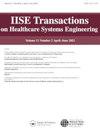逆心电建模的时空正则化
IF 1.5
Q3 HEALTH CARE SCIENCES & SERVICES
IISE Transactions on Healthcare Systems Engineering
Pub Date : 2020-10-07
DOI:10.1080/24725579.2020.1823531
引用次数: 9
摘要
摘要先进的传感技术,如可穿戴传感器网络,提供了一个前所未有的机会来捕捉与心脏时空电活动相关的丰富信息,并利用体表电位图的现成数据促进逆心电图(ECG)建模。然而,从体表测量中推导心脏表面电位通常具有挑战性,这被称为“逆ECG问题”。传统的回归不关心复杂几何形状中的时空动态变量,并且在处理高维时空数据以解决逆ECG问题的能力方面往往受到限制。本文对正则化方法在实现逆ECG问题鲁棒解方面的性能进行了比较研究。我们首先介绍了心电图的正向和反向问题。其次,我们提出了两个时空正则化(STRE)模型来提高逆ECG建模的鲁棒性。最后,对两个球体几何结构以及真实世界的躯干-心脏几何结构进行了案例研究,以评估不同正则化方法的性能。实验结果表明,在两种球体和躯干心脏几何结构中,与传统的Tikhonov正则化相比,STRE模型有效地解决了病态逆ECG问题,并分别获得了56.3%和67.3%的性能改进。时空正则化方法在实现逆ECG问题的高维预测建模的稳健解决方案方面具有强大的潜力。本文章由计算机程序翻译,如有差异,请以英文原文为准。
Spatiotemporal regularization for inverse ECG modeling
Abstract Advanced sensing such as the wearable sensor network provides an unprecedented opportunity to capture a wealth of information pertinent to space-time electrical activity of the heart, and facilitate the inverse electrocardiographic (ECG) modeling with the readily available data of body surface potential mapping. However, it is often challenging to derive heart-surface potentials from body-surface measurements, which is called the “inverse ECG problem.” Traditional regression is not concerned about spatiotemporal dynamic variables in complex geometries, and tends to be limited in the ability to handle high-dimensional spatiotemporal data for solving the inverse ECG problem. This paper presents a comparison study of regularization methods in the performance to achieve robust solutions of the inverse ECG problem. We first introduce the forward and inverse ECG problems. Second, we propose two spatiotemporal regularization (STRE) models to increase the robustness of inverse ECG modeling. Finally, case studies are conducted on the two-sphere geometry, as well as a real-world torso-heart geometry to evaluate the performance of different regularization methods. Experimental results show that STRE models effectively tackle the ill-conditioned inverse ECG problem and yield 56.3% and 67.3% performance improvement compared to the traditional Tikhonov regularization in the two-sphere and the torso-heart geometries, respectively. The spatiotemporal regularization methodology is shown to have strong potential to achieve robust solutions for high-dimensional predictive modeling in the inverse ECG problem.
求助全文
通过发布文献求助,成功后即可免费获取论文全文。
去求助
来源期刊

IISE Transactions on Healthcare Systems Engineering
Social Sciences-Safety Research
CiteScore
3.10
自引率
0.00%
发文量
19
期刊介绍:
IISE Transactions on Healthcare Systems Engineering aims to foster the healthcare systems community by publishing high quality papers that have a strong methodological focus and direct applicability to healthcare systems. Published quarterly, the journal supports research that explores: · Healthcare Operations Management · Medical Decision Making · Socio-Technical Systems Analysis related to healthcare · Quality Engineering · Healthcare Informatics · Healthcare Policy We are looking forward to accepting submissions that document the development and use of industrial and systems engineering tools and techniques including: · Healthcare operations research · Healthcare statistics · Healthcare information systems · Healthcare work measurement · Human factors/ergonomics applied to healthcare systems Research that explores the integration of these tools and techniques with those from other engineering and medical disciplines are also featured. We encourage the submission of clinical notes, or practice notes, to show the impact of contributions that will be published. We also encourage authors to collect an impact statement from their clinical partners to show the impact of research in the clinical practices.
 求助内容:
求助内容: 应助结果提醒方式:
应助结果提醒方式:


